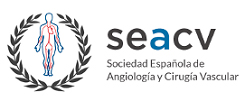Revisiones
Actualización de biomarcadores y terapias en pacientes con aneurisma aórtico abdominal
Mónica María Torres Fonseca, Carlos Esteban Gracia, Alina Velescu, Ana Apodaka, Luis Miguel Salmerón Febres
 Número de descargas:
33210
Número de descargas:
33210
 Número de visitas:
1501
Número de visitas:
1501
 Citas:
0
Citas:
0
Compártelo:
El aneurisma de aorta abdominal (AAA) es una patología en la que se produce la dilatación progresiva de la pared aórtica, lo que puede llevar a su rotura, un fenómeno mortal en más del 80 % de los casos. Presenta una prevalencia que, en varones de más de 65 años, puede alcanzar el 8 %. El manejo de los pacientes asintomáticos, con aneurismas por debajo de 55 mm de diámetro máximo, consiste en un seguimiento periódico con pruebas de imagen, en el control de los factores de riesgo cardiovascular y en el tratamiento con terapia antiagregante e hipolipemiante. Sin embargo, actualmente no existe ningún tratamiento farmacológico efectivo capaz de limitar su progresión o evitar su rotura. En la actualidad, el diámetro aórtico es el único marcador de riesgo de rotura, y es lo que determina la necesidad de reparación quirúrgica. En esta revisión se exponen las dificultades para disponer de biomarcadores efectivos para esta enfermedad, se actualizan los potenciales biomarcadores descritos hasta ahora y se plantean las estrategias para la identificación de nuevas dianas terapéuticas.
Palabras Clave: Aneurisma de aorta abdominal. Factores de riesgo. Biomarcador. Fisiopatología. Tratamiento médico.
DOI: 10.1038/nrcardio.2010.180
DOI: 10.1016/j.ejvs.2006.10.025
DOI: 10.1161/CIRCULATIONAHA.108.817619
DOI: 10.1136/bmj.328.7448.1122
DOI: 10.1002/bjs.7001
DOI: 10.1038/nrcardio.2009.80
DOI: 10.1093/cvr/cvq337
DOI: 10.1016/S0140-6736(05)66459-8
DOI: 10.1046/j.1365-2168.2000.01353.x
DOI: 10.1152/ajpheart.00519.2017
DOI: 10.1161/CIRCULATIONAHA.106.671859
DOI: 10.1016/j.jvs.2005.08.002
DOI: 10.1093/cvr/cvw082
DOI: 10.1161/ATVBAHA.112.300208
DOI: 10.1161/01.CIR.0000133279.07468.9F
DOI: 10.1161/CIRCULATIONAHA.107.720219
DOI: 10.1016/j.amjcard.2009.12.076
DOI: 10.1093/cvr/cvy174
DOI: 10.1002/bjs.9837
DOI: 10.1093/eurheartj/ehq171
DOI: 10.1161/circ.104.suppl_1.I-288
DOI: 10.1016/j.atherosclerosis.2011.11.023
DOI: 10.1161/CIRCULATIONAHA.115.016537
DOI: 10.1016/j.jneuroim.2009.07.004
DOI: 10.1161/ATVBAHA.108.173898
DOI: 10.1200/JCO.2009.23.5556
DOI: 10.1510/icvts.2009.208835
DOI: 10.1007/s10016-006-9038-7
DOI: 10.1177/1538574410361971
DOI: 10.1161/01.ATV.15.8.1145
DOI: 10.1016/S1078-5884(03)00178-3
DOI: 10.1161/CIRCULATIONAHA.107.735274
DOI: 10.1016/j.ejvs.2004.12.007
DOI: 10.1016/j.ejvs.2008.11.014
DOI: 10.1016/j.jvs.2008.03.064
DOI: 10.1067/mva.2002.125018
DOI: 10.1067/mva.2002.121071
DOI: 10.1067/mva.2002.121124
DOI: 10.1016/S1051-0443(07)61315-3
DOI: 10.1016/j.ejvs.2009.12.021
DOI: 10.1053/ejvs.2000.1151
DOI: 10.1016/j.ejvs.2007.12.004
DOI: 10.1177/2047487319873062
DOI: 10.1046/j.0007-1323.2001.01911.x
DOI: 10.1161/CIRCRESAHA.111.243758
DOI: 10.1136/jmg.2008.057851
DOI: 10.1177/1538574409334345
DOI: 10.1016/j.jvs.2006.12.019
DOI: 10.1067/mva.2000.107563
DOI: 10.1016/j.ejvs.2003.09.001
DOI: 10.1161/01.ATV.0000113292.00300.55
DOI: 10.1021/pr100250s
DOI: 10.1093/cvr/cvp048
DOI: 10.1016/j.avsg.2018.11.006
DOI: 10.1002/bjs.7465
DOI: 10.1016/j.jvs.2010.02.279
DOI: 10.1016/j.jvs.2012.01.003
DOI: 10.1515/CCLM.2008.336
DOI: 10.1172/JCI7709
DOI: 10.1042/CS20160970
DOI: 10.1371/journal.pone.0099302
DOI: 10.1016/j.atherosclerosis.2010.11.009
DOI: 10.1161/ATVBAHA.110.214429
DOI: 10.1016/j.avsg.2014.02.025
DOI: 10.1182/bloodadvances.2017013359
DOI: 10.1161/ATVBAHA.116.308874
DOI: 10.1177/0003319716660240
DOI: 10.1160/TH14-10-0874
DOI: 10.1016/j.avsg.2012.05.028
DOI: 10.1067/mva.2002.121308
DOI: 10.1053/ejvs.2000.1262
DOI: 10.1161/CIRCULATIONAHA.106.174526
DOI: 10.1016/S0002-9149(03)00431-4
DOI: 10.1038/ncomms14780
DOI: 10.1097/FJC.0000000000000540
DOI: 10.1093/eurheartj/ehw257
DOI: 10.1007/s00595-006-3367-6
DOI: 10.1016/j.jvs.2016.04.061
DOI: 10.1097/01.sla.0000150258.36236.e0
DOI: 10.1016/j.ejvs.2010.01.030
DOI: 10.1177/1538574408320027
DOI: 10.1016/j.ejvs.2021.06.013
DOI: 10.1016/j.ejvs.2021.01.023
DOI: 10.3390/jcm13030818
Originales: Enfermedad arterial periférica: la influencia de la etnia
Elena García Rivera , Enrique M San Norberto García , Cintia Flota Ruiz , Liliana Fidalgo Domingos , Carlos Vaquero-Puerta
Originales: Factores perioperatorios pronósticos en cirugía abierta de aneurisma de aorta abdominal yuxtarrenal
Jesús Fernández Bravo , Alejandro González García , Teresa Lidia Reyero Postigo , Patricia Lorena Torres Lebruno , Ana Begoña Arribas Díaz , César Aparicio Martínez
Originales: Pronóstico tardío de pacientes supervivientes tras la reparación quirúrgica abierta de un aneurisma de aorta abdominal roto
Andoni González Fernández , Ángel Barba Vélez , Melina Vega de Céniga , Xabier Cabezuelo Adame , Luis Estallo Laliena
Artículos Especiales: Código aneurisma. ¿Una realidad necesaria?
Rosa María Moreno Carriles
Originales: Prevalencia de aneurismas de aorta abdominal en una población de riesgo en una consulta de cirugía vascular
Estrella Blanco Cañibano , Pilar Caridad Morata Barrado , Miguel Muela Méndez , Beatriz García Fresnillo , Mercedes Guerra Requena
Casos Clínicos: A propósito de un caso de endotensión asociada a apendicitis
Jennifer Mondragón Zamora , Marta Gutiérrez Nistal , Marta Lavirgen Labrador , Teresa Hernández Ruiz , Álvaro Fernández Heredero
Artículos Especiales: Actualización y algoritmos de toma de decisión en el manejo del aneurisma aórtico abdominal roto
Marta Ballesteros-Pomar , Silvia Maqueda Ara , Cristina Nogal Arias , Nuria Sanz Pastor , Marcos del Barrio Fernández , Luis Ángel Suárez González , Rafael Fernández-Samos Gutiérrez
Originales: Análisis volumétrico e influencia del trombo intraluminal tras la reparación endoluminal del aneurisma de aorta abdominal
M.ª Lourdes del Río-Solá , Jaime Finat-Saez , Carlos Vaquero-Puerta
Casos Clínicos: Isquemia arterial aguda de extremidades por migración de endoprótesis
Alejandra Bartolomé Sánchez , Jorge Coghi Granados , Manoela Oliveira Brito , Mireia Rallo Romero , Abel Vélez Lomana
Casos Clínicos: Tratamiento quirúrgico de aneurisma de aorta abdominal en paciente con riñón único de localización pélvica
Mario Altable García , Rosario Jiménez Palmer , Marta Zaplana Córdoba , Vicente Sala Almonacil
Originales: Factores de riesgo cardiovascular en isquemia crónica de extremidades inferiores: importancia de la intervención del cirujano vascular
Cartas al Director: Comentarios bibliográficos. Restenosis después de la angioplastia-stent de la arteria renal: incidencia y factores de riesgo
Originales: Evolución del diámetro iliaco tras resección de aneurisma aórtico e interposición de injerto aorto-aórtico
Originales: Prevalencia de aneurismas de aorta abdominal en varones de 65 años de la Comarca Interior de Bizkaia (Estudio PAV65)
Cartas al Director: Aneurisma de aorta abdominal en paciente joven con síndrome de Marfan
Artículos Especiales: Guía de seguimiento no invasivo del tratamiento endovascular del aneurisma de aorta abdominal
Revisiones: Guía clínica. Tratamiento endovascular del aneurisma de aorta abdominal
Originales: Influencia de la elevación del índice tobillo/brazo en el riesgo cardiovascular y supervivencia en varones adultos sin enfermedad arterial periférica
Imagen Clínica del Mes: Aneurisma de aorta abdominal roto con fístula aortocava
Originales: Seguimiento de la estenosis carotídea en pacientes asintomáticos: ¿se debe llevar a cabo en todos los pacientes?
Editoriales: Veinte años de tratamiento endovascular del aneurisma de aorta abdominal. ¿Estamos dispuestos a abandonar la cirugía convencional?
Originales: Tratamiento del aneurisma de aorta abdominal roto: ¿EVAR o cirugía abierta?
Originales: Comparación de modelos de riesgo para reparación endovascular y abierta por rotura de aneurisma aórtico abdominal
Editoriales: ¿Es factible un cribado de aneurisma de aorta abdominal en España?
Originales: Valor pronóstico de la anatomía EVAR en el tratamiento quirúrgico del aneurisma de aorta abdominal roto
Originales: Asociación de PCR plasmática y evolución del aneurisma de aorta infrarrenal
Notas Técnicas: Análisis biomecánico con análisis por elementos finitos del aneurisma de aorta abdominal, una herramienta prometedora para la evaluación del riesgo de rotura
Originales: Evolución de los factores de riesgo cardiovascular entre 2004 y 2009 en la cohorte del estudio del Riesgo de Enfermedad Cardiovascular en Castilla y León (RECCyL)
Artículos Especiales: Recomendaciones de la guía para el diagnóstico y tratamiento del aneurisma de aorta abdominal
Cartas al Director: La selectina P soluble, nuevo biomarcador para el diagnóstico de la enfermedad tromboembólica venosa
Cartas al Director: Los factores de riesgo cardiovascular. Impacto sobre la claudicación intermitente
Originales: Expresión proteica de metaloproteinasa-2 (MMP-2) y su inhibidor tisular (TIMP-2) en aorta, fascia y plasma de pacientes con aneurisma de aorta abdominal
Originales: Estudio de biomarcadores y modelos predictivos de crecimiento en el aneurisma de aorta abdominal
Originales: Evolución del perfil de los pacientes sometidos a cirugía abierta de aneurisma de aorta abdominal en la era endovascular
Cartas al Director: Coste del tratamiento del aneurisma de aorta abdominal: cirugía abierta frente a tratamiento endovascular
Originales: La osteopontina como biomarcador de riesgo neurológico en la enfermedad carotídea
Originales: Estudio prospectivo aleatorizado sobre el impacto de las medidas fast track en la cirugía abierta de aneurismas de aorta abdominal
Cartas al Director: Tratamiento endovascular de aneurisma de aorta abdominal en paciente trasplantado renal con oclusión de ilíaca externa ipsilateral al injerto
Originales: Quistes renales y aneurismas de aorta de gran tamaño
Originales: Impacto del tratamiento endovascular en la morbimortalidad por aneurisma de aorta abdominal
Cartas al Director: Conversión a cirugía abierta, mediante explante endoprotésico, tras intento fallido de tratamiento endovascular, y persistencia de fuga Ia, en aneurisma de aorta abdominal roto
Originales: Sellado distal en ilíaca externa: ramificación ilíaca frente a la exclusión de la arteria hipogástrica
Originales: Estudio de selección de microRNA como posibles biomarcadores de aneurisma de aorta abdominal
Originales: Tratamiento del aneurisma de aorta infrarrenal roto: cirugía abierta versus tratamiento endovascular
Oscar Uclés Cabeza , Isaac Martínez López , Ferrán Plá Sánchez , Adriana Baturone Blanco , Francisco Javier Serrano Hernando
Artículos Especiales: Resección de aneurisma de aorta abdominal por vía retroperitoneal
Secundino Llagostera
Casos Clínicos: Aneurisma de aorta abdominal infrarrenal en paciente con situs inversus totalis y sus implicaciones terapéuticas
Oliver Bonnelly , Rubén Peña , José Carnicero , Francisco Lozano
Casos Clínicos: Un aneurisma de la aorta abdominal roto revela una enfermedad de Behçet
AZGHARI AMINE , Chetoui Ayoub , Jamaoui Ayoub , Mouyarden Wassim , Bouallala Amine , Rachidi Alaoui Siham
Revisiones: Actualización de biomarcadores para la detección precoz de isquemia intestinal
Enrique Guerrero González , Andrés Reyes Valdivia , Julia Ocaña Guaita , Claudio Gandarias Zuñiga
Originales: Relación de los índices neutrófilo-linfocito y plaquetas-linfocito con desenlaces de severidad en isquemia aguda de miembros inferiores
Jenith Rocío Lagos Castro , Katheryn Daniela Lagos Castro , William Ramírez Herrán , Óscar Alonso Villada Ochoa , María Alejandra Camacho Mazabuel
Cartas al Director: Comentario a "The effect of diabetes on abdominal aortic aneurysm growth over 2 years"
Manel Arrébola López
Artículos Especiales: Resección de aneurisma de aorta abdominal infrarrenal por vía transperitoneal
Javier Villaverde Rodríguez
Originales: Manejo de la trombosis venosa mesentérica en un hospital de segundo nivel
Isabel Valentín-Gamazo González , Juan Berrocal Cuadrado , Carlenny Suero Rodríguez , Victoria Maderuelo García , Ana Huidobro Píriz
Cartas al Director: Respuesta a: “Cribado poblacional de aneurismas de aorta abdominal. Estudio piloto en Salamanca”
Ruth Fuente Garrido , Gonzalo González-Pérez , Natalia Moradillo-Renuncio , Ignacio de Loyola Agúndez Gómez
Originales: Prevalencia y factores de riesgo de la enfermedad venosa crónica en estudiantes de Medicina
Marco Antonio Ayala García , Lisandra Soto Saldaña , Gilberto Flores Vargas , Polo René Barrios Bañuelas , Carlos Iván Minguela Bravo , Miguel Ángel Vázquez Guerrero
Artículos Especiales: Evaluación de la implantación de un programa de cribado de aneurisma de aorta abdominal en España
Melina Vega de Céniga , Anna Godo Pla , Gonzalo Bravo-Soto , Antoni Sisó-Almirall , Marta Trapero Bertran , Ana Magdalena Vargas Martínez , Maria-Dolors Estrada Sabadell , Rosa María Vivanco Hidalgo
Revisiones: Índice de salud bioenergética y biomarcadores del estrés oxidativo en la enfermedad arterial periférica: revisión sistemática y metaanálisis
M.ª Lourdes del Río-Solá , Sergio Asensio-Rodríguez , Miriam Peral-Rodrigo , Carmen García-Rodríguez
Originales: Los biomarcadores hemostáticos y la volumetría ayudan a identificar los aneurismas de aorta abdominal de alto riesgo
Sebastián Fernández Alonso , Esther Martínez Aguilar , Susana Ravassa , Josune Orbe , José Antonio Páramo , Leopoldo Fernández Alonso , Carmen Roncal
Originales: Comparación de la dosis de radiación local con los niveles de referencia diagnóstica nacionales en la reparación endovascular de aneurismas de aorta infrarrenal
Dorelly Tanayra Martínez del Carmen , Wiktoria Aleksandra Zawadzka , Pablo Saldaña Gutiérrez , Regina Callejón Baño , Elena Iborra Ortega
Artículos Especiales: Resultados a corto, medio y largo plazo de la reparación endovascular urgente del aneurisma de aorta abdominal sintomático no roto
Elena Martín Morales , Javier Río Gómez , Fernando García Boyano , José Manuel Ligero Ramos
Casos Clínicos: Reparación de fístula aortoduodenal primaria con parche de pericardio bovino y aislamiento de Streptococcus equi
Mariana Montoya Bonilla , Henry Martínez , Ernesto Fajardo
Revisiones: Endofugas de tipo II tras EVAR: embolización de un complejo circuito
Sara González-Sánchez , Marta Herrero Gutiérrez , José Carlos Lodeiro Sanz , Juan Luis Portero García , Isabel María Breteau Agote , Fernando Ruiz Grande
Artículos más populares
Casos Clínicos: Escalenectomía con resección de la primera costilla bajo abordaje supraclavicular para el tratamiento del síndrome de opérculo torácico vascular
Introducción: el síndrome de opérculo torácico vas...
Casos Clínicos: Injerto en estampillado y ozonoterapia: manejo de úlcera de pie diabético San Elián de grado III
Introducción: el pie diabético (PD) es una de las...
-
Licencia creative commons: Open Access bajo la licencia Creative Commons 4.0 CC BY-NC-SA
https://creativecommons.org/licenses/by-nc-sa/4.0/legalcode






